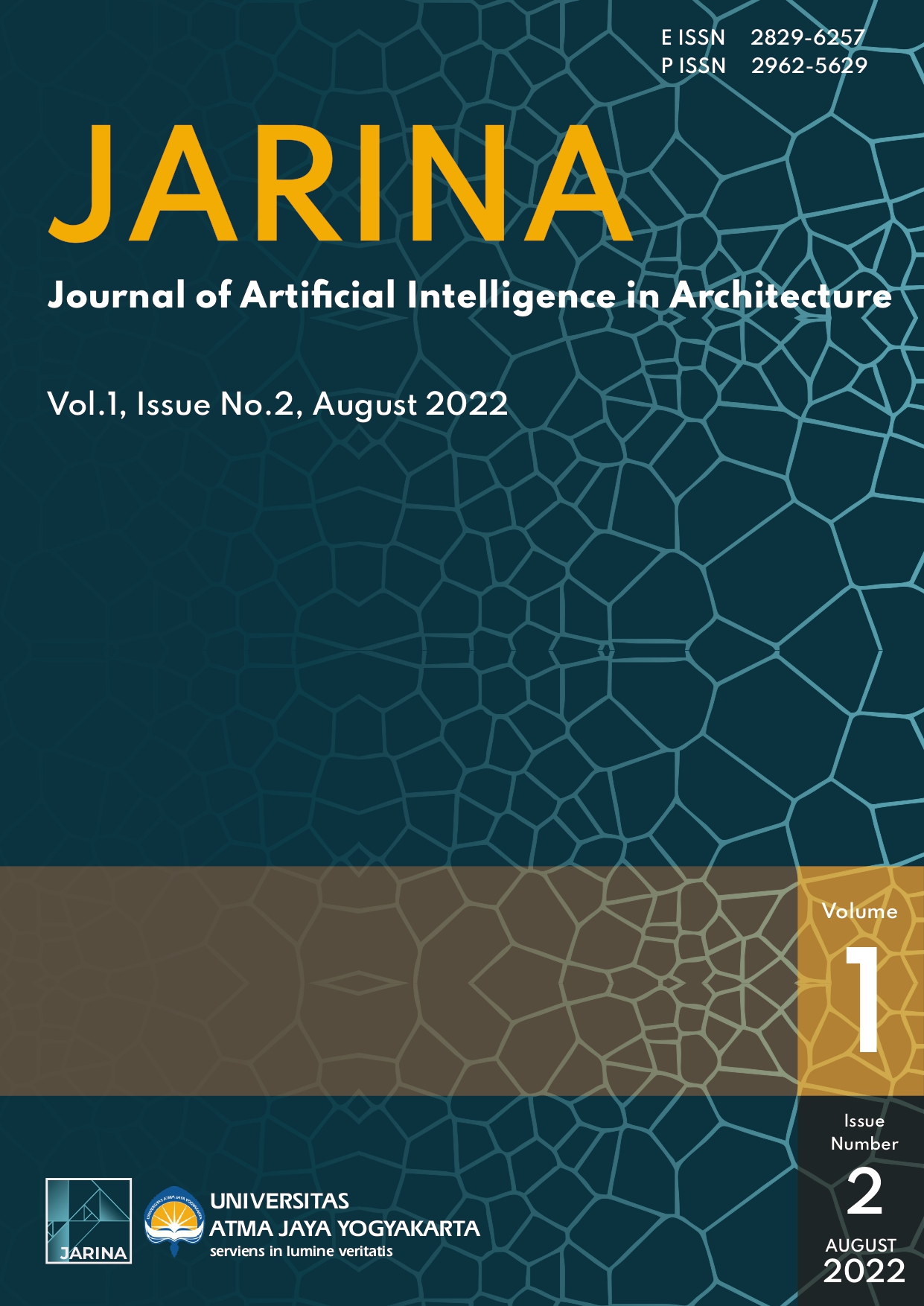The Influence of Circulation Patterns on The Visitor Distribution in A Shopping Mall Case Study Palembang Icon Shopping Center, Palembang City
DOI:
https://doi.org/10.24002/jarina.v1i1.5142Keywords:
Circulation pattern, Visitor distribution, Space syntax, DepthMapX simulationAbstract
Physiological needs are the most basic human needs. Shopping is one of the measures to fulfill physiological needs, such as clothing, foods, and drinks. Most people prefer to shop in shopping centers as it is more convenient and secure due to its regular spatial pattern, forming a good circulation pattern for their visitors. Palembang Icon is a shopping center in Palembang, located on Jl. POM IX, Lorok Pakjo, Ilir Barat I District, Palembang City, South Sumatra which considered has a good circulation pattern. Palembang Icon has a mall circulation pattern, namely a linear circulation pattern, one lane intended so that all retailers get a strategic place and the circulation orientation becomes clear. This research discusses the Palembang Icon shopping center's circulation pattern and analyzes its influence on the distribution of visitors by using the space syntax method with simulation using the DepthMapX application. The result shows that the circulation space's shape is closed, and the configuration of the circulation path is entirely a linear circulation pattern.
References
W. K. Noor and U. Qomariyah, “Hierarki Kebutuhan Sebagai Dasar Refleksi Diri Tokoh Dalam Novel Pesantren Impian,” J. Sastra Indones., vol. 8, no. 2, pp. 103–110, 2019, doi: 10.15294/jsi.v8i2.28750.
P. Hariyono, “Arsitektur Humanistik Menurut Teori Maslow,” Pros. SNST Fak. Tek., vol. 1, no. 1, pp. 26–31, 2014, Accessed: Feb. 07, 2022. [Online]. Available: https://publikasiilmiah.unwahas.ac.id/index.php/PROSIDING_SNST_FT/article/view/1039.
R. R. D. Asih and L. A. Pratomo, “Peran Mediasi E-Satisfaction dan E-Trust Terhadap E-Loyalty,” J. Manaj. dan Pemasar. Jasa, vol. 11, no. 1, pp. 125–144, Mar. 2018, doi: 10.25105/jmpj.v11i1.2537.
A. Syoufa and H. Hapsari, “Pengaruh Pola Sirkulasi Pusat Perbelanjaan Mal Terhadap Pola Penyebaran Pengunjung Studi Kasus: Margocity, Depok,” J. Ilm. Desain Konstr., vol. 13, no. 2, pp. 46–57, 2014, [Online]. Available: https://www.ejournal.gunadarma.ac.id/index.php/dekons/article/view/1135.
G. T. Sari, “Pusat Perbelanjaan Mall Di Kabupaten Kubu Raya,” J. online Mhs. Arsit. Univ. Tanjungpura, vol. 5, no. 2, pp. 1–12, Sep. 2017, Accessed: Feb. 07, 2022. [Online]. Available: https://jurnal.untan.ac.id/index.php/jmarsitek/article/view/21553.
R. Savitri, “Pusat Perbelanjaan Modern (Mall) Dengan Penekanan Ruang Terbuka Publik,” J. online Mhs. Arsit. Univ. Tanjungpura, vol. 6, no. 2, pp. 229–245, Jan. 2018, Accessed: Feb. 07, 2022. [Online]. Available: https://jurnal.untan.ac.id/index.php/jmarsitek/article/view/30631.
W. I. Rachmani and M. Hidayat, “Studi Penentuan Lokasi Potensial Pengembangan Pusat Perbelanjaan di Kota Tangerang,” J. PLANESA, vol. 2, no. 1, pp. 57–64, 2008, Accessed: Feb. 07, 2022. [Online]. Available: https://ejurnal.esaunggul.ac.id/index.php/planesa/article/view/535.
F. P. Lase, A. B. Purnomo, and Nuzuliar, “Penataan efisiensi sirkulasi ruang dalam dan ruang luar untuk disabilitas pada stasiun mrt lebak bulus 1),” Semin. Nas. Pakar ke-2, vol. 0, no. 0, pp. 1–8, Apr. 2019, Accessed: Feb. 07, 2022. [Online]. Available: https://www.trijurnal.lemlit.trisakti.ac.id/pakar/article/view/4159.
M. Lusiana and S. M. Sari, “Aplikasi Sirkulasi Fungsional pada Interior Shopping Mall ‘Tunjungan Plaza’ di Surabaya,” Intra, vol. 2, no. 2, pp. 555–562, 2014, [Online]. Available: http://publication.petra.ac.id/index.php/desain-interior/article/view/2245.
Andi, Z. Zain, and U. F. Andi, “Pengaruh Konfigurasi Ruang Terhadap Jumlah Pengunjung pada Bangunan Komersial Mal di Pontianak,” Ruang Sp., vol. 8, no. 1, pp. 45–60, 2021, Accessed: Feb. 07, 2022. [Online]. Available: https://ojs.unud.ac.id/index.php/ruang/article/view/63897/39357.
J. Oktaviana, “Pengaruh Pola Sirkulasi Terhadap Persebaran Pengunjung Pusat Perbelanjaan Palembang Icon,” Perpustakaan Universitas Katolik Musi Charitas, 2021.
S. A. Mutmainnah and I. Martiningrum, “Pola Persebaran Pengunjung di Mall Olympic Garden Malang,” J. Mhs. Jur. Arsit., vol. 6, no. 3, pp. 1–11, 2018, Accessed: Jan. 05, 2022. [Online]. Available: http://arsitektur.studentjournal.ub.ac.id/index.php/jma/article/view/600.
M. F. Romdhoni, “Analisis Pola Konfigurasi Ruang Terbuka Kota Dengan Penggunaan Metoda Space Syntax Sebagai Spatial Logic dan Space Use,” NALARs, vol. 17, no. 2, pp. 113–128, Jun. 2018, doi: 10.24853/nalars.17.2.113-128.
M. Karmila and N. S. Magfiroh, “USING SPACE SYNTAX TO DETERMINE THE FORM AND PATTERN OF HERITAGE SITE (Case Study: Sangiran Heritage Site),” J. Planol., vol. 15, no. 1, p. 81, 2018, doi: 10.30659/jpsa.v15i1.2762.
A. H. Sa’diyah, R. Nugroho, and O. Purwani, “Space Syntax Sebagai Metode Perancangan Ruang pada Galeri Kreatif di Kota Surakarta,” J. SENTHONG, vol. 2, no. 2, pp. 807–816, 2019, Accessed: Feb. 07, 2022. [Online]. Available: https://jurnal.ft.uns.ac.id/index.php/senthong/article/view/1052.
I. Nurhidayat, O. Purwani, and Samsudi, “Penerapan Teori Space Syntax Pada Bangunan Pusat Ekshibisi Di Jakarta,” Senthong, vol. 1, no. 2, pp. 153–160, Jul. 2018, Accessed: Feb. 07, 2022. [Online]. Available: https://jurnal.ft.uns.ac.id/index.php/senthong/article/view/715.
Published
How to Cite
Issue
Section
License
Copyright (c) 2022 Jessica Oktaviana, Dhita Wahyu Anggraeni

This work is licensed under a Creative Commons Attribution 4.0 International License.
Authors who publish with this journal agree to the following terms:
1.Authors retain copyright and grant the journal right of first publication with the work simultaneously licensed under a Creative Commons that allows others to share the work with an acknowledgement of the work's authorship and initial publication in this journal.
2.Authors are able to enter into separate, additional contractual arrangements for the non-exclusive distribution of the journal's published version of the work (e.g., post it to an institutional repository or publish it in a book), with an acknowledgement of its initial publication in this journal.
3.Authors are permitted and encouraged to post their work online (e.g., in institutional repositories or on their website) prior to and during the submission process, as it can lead to productive exchanges, as well as earlier and greater citation of published work (See The Effect of Open Access).

















